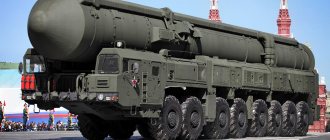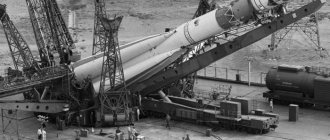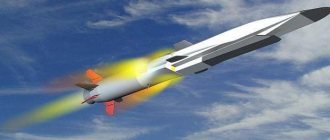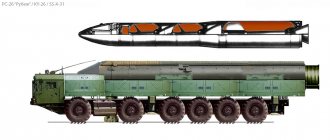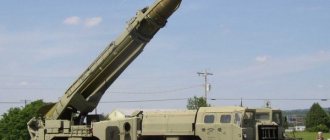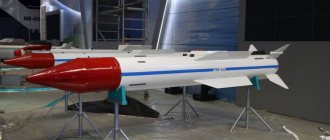An intercontinental ballistic missile (ICBM) is a weapon with a warhead and a flight range of up to 5,000 km. An ICBM is designed to destroy any target at medium to long range using a nuclear warhead.
Modern ballistic missiles are equipped with protection against enemy missile defense (camouflage, decoys, multiple warheads) and can easily overcome it. ICBMs are launched from stationary installations, nuclear submarines and mobile systems.
R-12U | Speed 3.8 km/s
R-12U is the fastest medium-range ballistic missile with a maximum speed of 3.8 km per second and opens the ranking of the fastest missiles in the world. The R-12U was a modified version of the R-12. The rocket differed from the prototype in the absence of an intermediate bottom in the oxidizer tank and some minor design changes - there are no wind loads in the shaft, which made it possible to lighten the tanks and dry compartments of the rocket and eliminate the need for stabilizers. Since 1976, the R-12 and R-12U missiles began to be removed from service and replaced with Pioneer mobile ground systems. They were withdrawn from service in June 1989, and between May 21, 1990, 149 missiles were destroyed at the Lesnaya base in Belarus.
Push or pull?
All warheads in a missile are in the so-called breeding stage or “bus”. Having been freed from the fairing, and then getting rid of the last booster stage, the expansion stage carries the warheads, as if to passengers at stops, along their own trajectories, along which the cones will each diverge towards their target.
The combat stage is also commonly called the “bus”, since it is responsible for the accuracy of pointing the warhead to the target point, that is, for combat effectiveness. Its operation and breeding stage is one of the largest sectors located in the rocket.
The dilution step can take different forms. Usually it looks like a wide loaf of bread or a round stump, on which warheads are mounted on spring pushers, points forward. They are located at precise separation angles (manually, on a missile base, using theodolites) and look in different directions, like the needles of a hedgehog, like a bunch of carrots. The platform, bristling with warheads, occupies a gyro-stabilized position in space, specified in space. And at certain moments, warheads are pushed out of it. They are ejected immediately after acceleration and separated from the last acceleration stage. Until this entire undiluted hive was shot down by anti-missile weapons or something on board the breeding stage failed.
But this happened before, at the beginning of the separating warheads. Today the division presents a different picture. If previously the warheads “stuck” forward, now the stage itself is in front and the warheads are at the bottom, with their tops back, inverted. In some rockets, the “bus” itself also lies upside down, in the upper stage of the rocket in a special recess. After separation, the propagation stage drags rather than pushes the warheads. Moreover, it drags, bracing itself with four “paws”, which are placed crosswise and deployed in front. At the ends of such paws there are traction nozzles of the expansion stage, directed backwards. After separation from the accelerating stage, the “bus” precisely and precisely sets its movement in the emerging space through its own guidance system. He himself takes the path of the next warhead - its personal path.
Then special inertia-free locks are opened, which hold the next detachable warhead. And not even separated, but simply now unconnected with the stage, the warhead hangs motionless right there, in complete weightlessness.
SM-65 Atlas | Speed 5.8 km/s
The SM-65 Atlas is one of the fastest American launch vehicles with a maximum speed of 5.8 km per second. It is the first developed intercontinental ballistic missile adopted by the United States. Developed as part of the MX-1593 program since 1951. It formed the basis of the US Air Force's nuclear arsenal from 1959 to 1964, but was then quickly withdrawn from service due to the advent of the more advanced Minuteman missile. It served as the basis for the creation of the Atlas family of space launch vehicles, which have been in operation since 1959 to this day.
UGM-133A Trident II | Speed 6 km/s
UGM -133 A Trident II is an American three-stage ballistic missile, one of the fastest in the world. Its maximum speed is 6 km per second. “Trident-2” has been developed since 1977 in parallel with the lighter “Trident-1”. Adopted into service in 1990. Launch weight - 59 tons. Max. throw weight - 2.8 tons with a launch range of 7800 km. The maximum flight range with a reduced number of warheads is 11,300 km.
Trajectory properties and practical implications
The movement of a body after the influence of the driving force on it ceases is studied by external ballistics. This science provides calculations, tables, scales, sights and develops optimal options for shooting. The ballistic trajectory of a bullet is a curved line described by the center of gravity of an object in flight.
Since the body is affected by gravity and resistance, the path that the bullet (projectile) describes forms the shape of a curved line. Under the influence of these forces, the speed and height of the object gradually decreases. There are several trajectories: flat, mounted and conjugate.
The first is achieved by using an elevation angle that is less than the angle of greatest range. If the flight range remains the same for different trajectories, such a trajectory can be called conjugate. In the case where the elevation angle is greater than the angle of greatest range, the path becomes called a suspended path.
The trajectory of the ballistic movement of an object (bullet, projectile) consists of points and sections:
- Departure (for example, the muzzle of a barrel) - this point is the beginning of the path, and, accordingly, the countdown.
- Weapon horizon - this section passes through the departure point. The trajectory crosses it twice: during release and during fall.
- The elevation section is a line that is a continuation of the horizon and forms a vertical plane. This area is called the firing plane.
- The apex of the trajectory is the point that is midway between the starting and ending points (shot and fall), and has the highest angle along the entire path.
- Aims - the target or sighting location and the beginning of the object's movement form the aiming line. An aiming angle is formed between the horizon of the weapon and the final target.
RSM 56 Mace | Speed 6 km/s
RSM 56 Bulava is one of the fastest solid-propellant ballistic missiles in the world, in service with Russia. It has a minimum damage radius of 8000 km and an approximate speed of 6 km/s. The development of the rocket has been carried out since 1998 by the Moscow Institute of Thermal Engineering, which developed it in 1989-1997. ground-based missile "Topol-M". To date, 24 test launches of the Bulava have been carried out, fifteen of them were considered successful (during the first launch, a mass-sized prototype of the rocket was launched), two (the seventh and eighth) were partially successful. The last test launch of the rocket took place on September 27, 2016.
Nuclear suitcase
Possession of ICBMs with nuclear warheads imposes great responsibility - it is necessary to exclude the possibility of an accidental missile launch and the outbreak of a nuclear war. For this purpose, special codes were invented, stored in a “nuclear suitcase” . In the USSR/Russia, the “nuclear suitcase” is the “Cheget” system . Only the president can distribute codes to launch complexes. On the ground, these codes will be entered into the “brain” of the ICBM, and two operators will be able to launch the missile, performing operations in parallel, “in two keys.”
But the enemy’s first strike can destroy both the president and the “suitcase.” Therefore, to dub “Cheget” in the mid-1980s. created the Perimeter control system . It is turned on during a threatened period, but Perimeter will not work as long as it receives “holding” signals from the control center of the Strategic Nuclear Forces. If there is no signal and no response to the request, “Perimeter” will launch a “control” rocket without human intervention, and it will give a command to start to all launchers in the country. When Perimeter is turned on, it is like holding a grenade in your hand with the pin pulled out. Until the grenade is released, there will be no explosion, but if the person holding the grenade is killed, an explosion is inevitable. Therefore, in the West, “Perimeter” is called “dead hand”. “Perimeter” made a retaliatory strike inevitable, and this discouraged the enemy from attacking with nuclear missile weapons.
Share link
Minuteman LGM-30G | Speed 6.7 km/s
The Minuteman LGM -30 G is one of the fastest land-based intercontinental ballistic missiles in the world. Its speed is 6.7 km per second. The LGM-30G Minuteman III has an estimated flight range of 6,000 kilometers to 10,000 kilometers, depending on the type of warhead. Minuteman 3 has been in US service from 1970 to the present day. It is the only silo-based missile in the United States. The first launch of the rocket took place in February 1961, modifications II and III were launched in 1964 and 1968, respectively. The rocket weighs about 34,473 kilograms and is equipped with three solid propellant engines. It is planned that the missile will be in service until 2022.
Last segment
But from an aerodynamic point of view, the stage is still not a warhead. If that one is a heavy and small narrow carrot, then the stage is more like an empty, vast bucket with empty fuel tanks, an oversized, streamlined body and a lack of orientation in the flow that is beginning to flow. The step with its wide body responds much earlier to the first blows of the oncoming flow. In addition, the warheads unfold along the flow, penetrating the atmosphere with the least aerodynamic resistance. The step, with its vast bottoms and sides, leans into the air. It cannot fight the braking force of the flow. Its ballistic coefficient - a combination of compactness and massiveness - is much worse than a warhead. It suddenly begins to slow down and gradually lags behind the warheads. However, the flow forces inexorably increase, and at the same time the temperature heats up the unprotected thin metal, depriving it of its strength. The remaining fuel simmers merrily in the hot tanks. Finally, the hull becomes unstable under the influence of aerodynamic load. Such an overload helps to destroy the bulkheads inside. The crumpled body is quickly engulfed by hypersonic shock waves, tearing the stage into pieces and scattering them. The pieces, having flown a little in the condensing air, again break into even smaller fragments. Remaining fuel reacts instantly. Flying fragments of structural components made of magnesium alloys ignite and instantly burn with a bright flash, reminiscent of a camera - it was not for nothing that magnesium was set on fire in the first photo flashes!
Now everything is on fire, everything is covered in hot plasma and shines brightly around in orange. The sailier and lighter parts are blown into the tail, which is stretched along it, and the denser ones go to slow down forward. All burning elements produce dense smoke plumes, although at such high speeds these dense plumes cannot exist due to the monstrous dilution by the flow. But from a distance they are clearly visible. The ejected smoke particles are stretched along the trail of the caravan of bits and pieces, resulting in a white trail visible in the atmosphere. Impact ionization affects the greenish night glow from this plume. Due to the irregular shape of the fragments, their deceleration is very rapid: everything that is not burned loses speed and, at the same time, the incendiary effect of the air. The strongest brake is supersonic. Having stood in the sky and cooled by the high-altitude frosty subsound, the strip of fragments is not visible, it loses its shape and structure, and also turns into a long (20 minutes), chaotic and quiet dispersion in the air. So there is no breeding step.
53T6 "Cupid" | Speed 7 km/s
53T6 "Amur" is the fastest anti-missile missile in the world, designed to destroy highly maneuverable targets and high-altitude hypersonic missiles. Tests of the 53T6 series of the Amur complex began in 1989. Its speed is 5 km per second. The rocket is a 12-meter pointed cone with no protruding parts. Its body is made of high-strength steel using composite winding. The design of the rocket allows it to withstand large overloads. The interceptor launches with 100-fold acceleration and is capable of intercepting targets flying at speeds of up to 7 km per second.
"Satan" SS-18 (R-36M) | Speed 7.3 km/s
"Satan" SS-18 (R-36M) is the most powerful and fastest nuclear missile in the world with a speed of 7.3 km per second. It is intended, first of all, to destroy the most fortified command posts, ballistic missile silos and air bases. The nuclear explosives of one missile can destroy a large city, a very large part of the United States. Hit accuracy is about 200-250 meters. The missile is housed in the world's strongest silos. The SS-18 carries 16 platforms, one of which is loaded with decoys. When entering a high orbit, all “Satan” heads go “in a cloud” of false targets and are practically not identified by radars.”
Modern developments in ballistics
Since military missiles of any kind are dangerous to life, the main task of defense is to improve the launch points of the striking systems. The latter must ensure the complete neutralization of intercontinental and ballistic weapons at any point of movement. A multi-tier system is proposed for consideration:
- This invention consists of separate tiers, each of which has its own purpose: the first two will be equipped with laser-type weapons (homing missiles, electromagnetic guns).
- The next two sections are equipped with the same weapons, but designed to destroy the head parts of enemy weapons.
Developments in defense missile technology do not stand still. Scientists are modernizing a quasi-ballistic missile. The latter is presented as an object that has a low path in the atmosphere, but at the same time sharply changes direction and range.
The ballistic trajectory of such a missile does not affect its speed: even at an extremely low altitude, the object moves faster than a normal one. For example, the Russian-developed Iskander flies at supersonic speeds - from 2100 to 2600 m/s with a mass of 4 kg 615 g; missile cruises move a warhead weighing up to 800 kg. During flight, it maneuvers and evades missile defenses.
DongFeng 5A | Speed 7.9 km/s
The DongFeng 5A intercontinental ballistic missile with a maximum speed of 7.9 km per second opens the top three fastest in the world. The Chinese DF-5 ICBM entered service in 1981. It can carry a huge 5 MT warhead and has a range of over 12,000 km. The DF-5 has a deflection of approximately 1 km, which means that the missile has one purpose - to destroy cities. The warhead's size, deflection and the fact that it only takes an hour to fully prepare for launch all mean that the DF-5 is a punitive weapon, designed to punish any would-be attackers. The 5A version has increased range, improved 300m deflection and the ability to carry multiple warheads.
The abysses of mathematics
Above we looked at how a warhead's own path begins. However, if we consider this process in more detail and delve into the topic, we can understand that today the turn in space of the carrier warhead, the deployment stage, is the scope of application of quaternion calculus, where the on-board orientation system processes the indicators of its movement with the continuous construction of the orientation quaternion on board. A quaternion is a complex number, but not with the usual 2 parts, imaginary and real, but with three imaginary and one real. In total, the quaternion has 4 parts, which is what the Latin root quatro says.
The propagation stage performs its work quite low, immediately after the boost stages are turned off (at an altitude of 100-150 km). It is worth noting that there is also the influence of gravitational anomalies on the Earth’s surface, heterogeneities in the even gravitational field that surrounds the Earth. They came from uneven terrain, occurrence of porosities of varying densities, mountain systems, and oceanic depressions. Moreover, gravitational anomalies either slightly release the step with additional attraction or, conversely, attract it towards themselves.
In these irregularities, the complex ripples of the gravitational field, the breeding stage must place the warheads with maximum precision. To do this, it was necessary to develop a more detailed map of the Earth's gravitational field. It is better to study the features of a relief field in systems of differential equations that describe precise ballistic motion. These are capacious, large (to include details) systems, consisting of several thousand differential equations with several tens of thousands of constant numbers. In this case, the gravitational field itself at low altitudes in the near-Earth region is considered as a joint attraction of several hundred point masses of various weights, located in a certain order near the center of the Earth. In this way, a more accurate simulation of the Earth's real gravitational field is achieved along the rocket's flight path. The flight control system works more accurately with it.
R-7 | Speed 7.9 km/s
R-7 - Soviet, the first intercontinental ballistic missile, one of the fastest in the world. Its top speed is 7.9 km per second. The development and production of the first copies of the rocket was carried out in 1956-1957 by the OKB-1 enterprise near Moscow. After successful launches, it was used in 1957 to launch the world's first artificial Earth satellites. Since then, launch vehicles of the R-7 family have been actively used to launch spacecraft for various purposes, and since 1961, these launch vehicles have been widely used in manned astronautics. Based on the R-7, a whole family of launch vehicles was created. From 1957 to 2000, more than 1,800 launch vehicles based on the R-7 were launched, of which more than 97% were successful.
What is a ballistic missile
A ballistic missile is a projectile that hits a target along an uncontrolled trajectory.
Considering this aspect, it has two stages of flight:
- a short controlled stage, according to which further speed and trajectory are set;
- free flight - having received the main command, the projectile moves along a ballistic trajectory.
Often, such weapons use multi-stage acceleration systems. Each stage is disconnected after fuel has been spent, which allows the projectile to increase in speed by reducing weight.
The development of a ballistic missile is associated with the research of K. E. Tsiolkovsky. Back in 1897, he determined the relationship between the speed under the influence of the thrust of a rocket engine, its specific impulse, and the mass at the beginning and end of the flight. The scientist’s calculations still occupy the most important place in design.
The next important discovery was made by R. Goddard in 1917. He used a liquid rocket engine for the Laval nozzle. This solution doubled the power plant and had a significant response in subsequent work by G. Oberth and the team of Wernher von Braun.
In parallel with these discoveries, Tsiolkovsky continued his research. By 1929, he had developed a multi-stage principle of propulsion taking into account earth's gravity. He also developed a number of ideas for optimizing the combustion system.
Hermann Oberth was one of the first to think about applying such discoveries in the field of astronautics. However, before him, the ideas of Tsiolkovsky and Goddard were implemented by the team of Wernher von Braun in the military sphere. It was on the basis of their research that the first mass-produced V-2 (V2) ballistic missiles appeared in Germany.
On September 8, 1944, they were used for the first time during the bombing of London. However, during the Allied occupation of Germany, all research documents were taken out of the country. Further developments were carried out by the USA and the USSR.
RT-2PM2 "Topol-M" | Speed 7.9 km/s
RT-2PM2 Topol-M (15Zh65) is the fastest intercontinental ballistic missile in the world with a maximum speed of 7.9 km per second. The maximum range is 11,000 km. Carries one thermonuclear warhead with a power of 550 kt. The silo-based version was put into service in 2000. The launch method is mortar. The rocket's sustaining solid-propellant engine allows it to gain speed much faster than previous types of rockets of a similar class created in Russia and the Soviet Union. This makes it much more difficult for missile defense systems to intercept it during the active phase of the flight.
https://www.youtube.com/watch?v=i73HE-B0JPs
65 6
